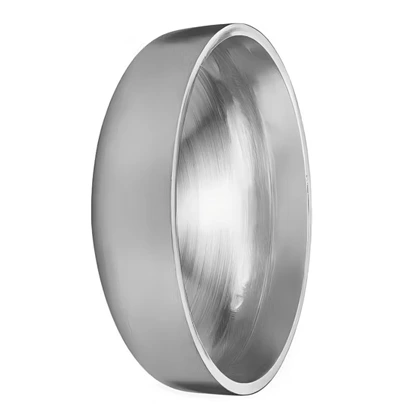Several Process Characteristics Of Butt-welded Pipe Caps
In modern pipeline engineering, stainless steel weld caps are a common and critical component, widely used in industries such as petroleum, natural gas, and chemicals. Their manufacturing process directly affects the safety, durability, and stability of the pipeline system. Understanding the manufacturing process of butt-welded pipe caps can help improve their quality and ensure the normal operation of the pipeline system. This article will explore the characteristics of several common butt-welded pipe cap manufacturing processes to better select the appropriate process for practical applications.
Manufacturing Process Flow of Butt-Welded Pipe Caps
The manufacturing process of weld on pipe caps steel involves multiple stages, with key processes including raw material selection, mold forming, welding, heat treatment, and final inspection.
-
Raw Material Selection: High-quality steel is the foundation for manufacturing pipe caps. Materials that meet relevant standards are typically selected to ensure the product's strength and durability.
-
Mold Forming: According to design requirements, the preliminary shape of the butt-welded pipe cap is formed using methods such as mold pressing or machining. This stage determines the shape and dimensional accuracy of the cap.
-
Welding Process: Welding is a crucial step in the entire manufacturing process, directly affecting the sealing performance and strength of the cap. Common welding methods include manual butt welding and automated butt welding. The former is suitable for small-batch production of special sizes, while the latter ensures higher welding quality and production efficiency.
-
Heat Treatment: Welded caps often require heat treatment to eliminate internal stress generated during welding and improve the material's mechanical properties.
-
Final Inspection: After production is complete, each butt-welded cap undergoes rigorous quality inspection to ensure it meets industry standards. Common testing methods include ultrasonic testing and X-ray inspection.
The Impact of Welding Process on Cap Performance
The welding process is one of the core factors affecting the performance of butt-welded caps. The quality of the weld not only determines the connection strength of the cap but also directly affects its compressive strength, temperature resistance, and other properties.
-
Manual Butt Welding: Suitable for small-batch production or caps of special sizes. Manual operation allows for flexible adjustment of the welding process, but the weld quality may be uneven.
-
Automatic Butt Welding: For large-scale production, automated welding can improve the uniformity of the weld joint, reduce human error, and ensure more stable welding quality for each cap. This method is particularly suitable for applications where butt weld pipe cap need to withstand significant pressure and temperature variations.
Automatic butt welding effectively improves production efficiency while ensuring product consistency, and is currently the mainstream welding process.
The Role of Heat Treatment
For butt-welded pipe caps, post-weld heat treatment is crucial. Heat treatment can improve the hardness, pressure resistance, and corrosion resistance of the caps, especially in high-temperature or high-pressure environments, effectively extending their service life.
-
Normalizing: Used to homogenize the grain structure of the steel, improving the overall performance of the material.
-
Annealing: Eliminates internal stress generated during welding, improving the toughness of the cap.
-
Quenching: Improves the hardness and wear resistance of the cap, particularly suitable for applications requiring high wear resistance.
Through a reasonable heat treatment process, stainless buttweld caps can better adapt to harsh working conditions, ensuring long-term stable operation.
The Key to Quality Control
Quality control is an indispensable part of butt-welded pipe cap production, directly related to product safety and reliability.
-
Raw Material Inspection: Selecting standard-compliant steel is the first step in ensuring pipe cap quality. Substandard materials may result in insufficient strength or poor corrosion resistance.
-
Welding Quality Inspection: After welding, rigorous non-destructive testing, including ultrasonic and X-ray inspection, must be performed to ensure the weld is free of cracks, porosity, and other defects.
-
Post-Heat Treatment Inspection: After heat treatment, the hardness, compressive strength, and other properties of the pipe cap need to be tested to ensure they meet design requirements.
Through comprehensive quality control, butt-welded pipe caps can perform optimally in various environments, reducing the risk of failure.
Wide Applications of Butt-Welded Pipe Caps
stainless steel buttweld caps are widely used in the oil, natural gas, power, and chemical industries. Because these fields have extremely high safety requirements for pipelines, the use of butt-welded pipe caps effectively ensures the sealing and stability of the pipelines.
-
Oil and Natural Gas: In the transportation of oil and natural gas, butt-welded pipe caps can be used at the sealing ends or connection points of pipelines to ensure safe operation under high pressure and high temperature environments.
-
Chemical and Power Industries: In industries such as chemical engineering and power generation, pipelines often need to withstand high temperatures, high pressures, or corrosive environments. Butt-welded pipe caps, through optimized processes, can provide higher compressive strength and corrosion resistance.
Balancing Cost and Efficiency
When producing butt-welded pipe caps, optimizing costs and improving production efficiency while ensuring quality are crucial factors for companies.
-
Manual Welding: While suitable for custom orders, its low efficiency and high labor costs typically limit its application to small-batch production.
-
Automated Production: Automated butt welding can significantly improve production efficiency, reduce production costs, and provide consistently high-quality products in large-scale production.
By rationally selecting production processes and welding methods, companies can optimize production costs and enhance market competitiveness while ensuring cap quality.
Conclusion
In summary, the production process of steel buttweld caps covers the entire process from raw material selection to final quality inspection, and each step has a crucial impact on product quality and performance. Welding processes, heat treatment, and strict quality control are key factors ensuring stable operation under high-temperature and high-pressure environments. As industrial demands continue to rise, the manufacturing process for welded pipe caps will also be continuously improved to meet increasingly stringent application requirements.
